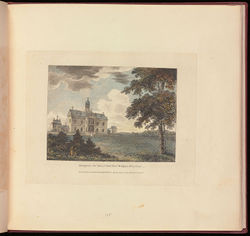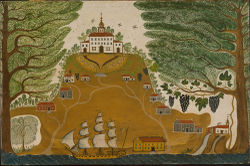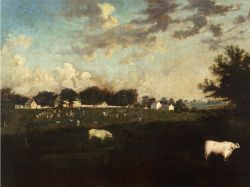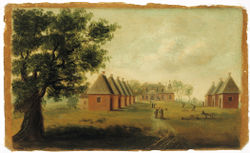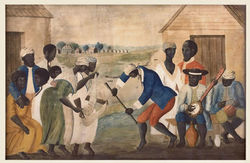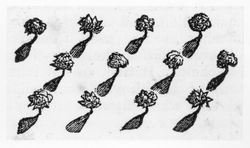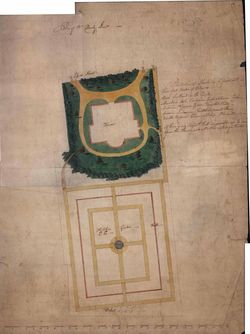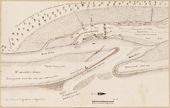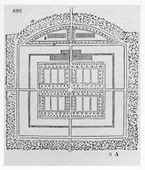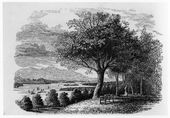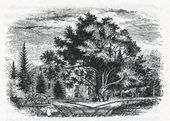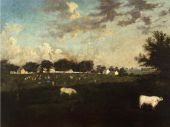Difference between revisions of "Plantation"
V-Federici (talk | contribs) m (→Associated) |
V-Federici (talk | contribs) m (→Inscribed) |
||
| Line 289: | Line 289: | ||
File:2249.jpg|Unknown, Derby Garden, [circa 1795–1799], Samuel McIntire Papers, MSS 264, flat file, plan 107. Courtesy of Phillips Library, Peabody Essex Museum, Rowley, MA. “Plantation of [[Shrub]]s to be faced with a three foot [[border]] of Flowers.” | File:2249.jpg|Unknown, Derby Garden, [circa 1795–1799], Samuel McIntire Papers, MSS 264, flat file, plan 107. Courtesy of Phillips Library, Peabody Essex Museum, Rowley, MA. “Plantation of [[Shrub]]s to be faced with a three foot [[border]] of Flowers.” | ||
| − | File:0155.jpg|John L. Boqueta de Woiseri, ''A [[View]] of New Orleans taken from the plantation of Marigny'', November 1803. | + | File:0155.jpg|John L. Boqueta de Woiseri, ''A [[View]] of New Orleans taken from the '''plantation''' of Marigny'', November 1803. |
File:0605.jpg|Lieut. Birch, ''Plan of St. Augustine, Fla.'', 1819. “'''Plantation'''” inscribed on the left near the margin. | File:0605.jpg|Lieut. Birch, ''Plan of St. Augustine, Fla.'', 1819. “'''Plantation'''” inscribed on the left near the margin. | ||
Latest revision as of 19:03, February 3, 2021
History
Noah Webster's 1828 definition of plantation includes three meanings relevant to landscape architecture, all of which were in use from the 17th through mid-19th centuries: a cultivated estate, a settlement in a new country, and a ground planted with trees, as opposed to naturally occurring growth. Americans were familiar with all these meanings. The term was used to describe a settlement or town, such as Salem or “New Plimouth,” as well as the individual holdings of a planter, as conveyed by an anonymous writer in 1626. Virginia landowner William Byrd II also described his estate, Westover, as a plantation and wrote about raising plantations of trees in a letter to the plant collector Peter Collinson. Timothy Dwight's 1796 travel account of New England used all three meanings of the term, describing the region’s towns, the estate of Cobble Hill in Charlestown, Massachusetts, and groupings of trees or groves each as “gay and fertile” plantations. The use of the term “plantation” to describe a colony or new settlement was prevalent only in the earliest colonial period, and it seems to have faded by the late 18th century.
Most frequently, however, plantation referred to a cultivated estate, a peculiarly American use of the term, as both Ephraim Chambers (1741–43) and Webster (1828) noted.[1] It was applied to farms of all sizes throughout the English-speaking colonies during the period under study: Green-springs, William Fitzhugh’s estate in James City County, Virginia (1686); Fitterasso, Dr. Baron’s estate in Charleston, South Carolina (1799); Hampton, in Baltimore County, Maryland (1808) [Fig. 1]; and Wye House, Col. Edward Lloyd’s estate in Talbot County, Maryland (1825). Webster noted that from Maryland northward such sites were called farms rather than plantations, but descriptions indicate that such distinctions were not always made consistently, at least by traveling observers. The term often became part of the proper name of many estates such as John Couper and James Hamilton Couper’s Hopeton Plantation, near Darien, Georgia; Hugh Fraser Grant’s Elizafield Plantation, in Glynn County, Georgia; and Roger Moore’s Orton Plantation, near Southport, North Carolina.
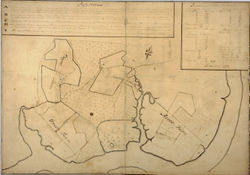
The word “plantation” today conjures up perhaps one of the most evocative images of the American landscape: vast tracts of land surrounding elegant mansions of the antebellum South. This image, however, with a majestic Greek Revival house, spreading lawns, and extensive fields worked by legions of enslaved people is more a product of 19th-and 20th-century fiction and film than an accurate description of the antebellum southern landscape.[2] In actuality the southern planter’s house was much more likely to be a one- or two-room log house with a long porch, shed behind, and various scattered service buildings.[3] Even so, large plantations did exist throughout the South, although they were in the minority, and they elicited some of the most detailed descriptions and images. Plans such as those of Marigny Plantation in New Orleans [Fig. 2] and of Mount Vernon [Fig. 3] illustrate the variety of arrangements of plantation landscapes. Their sizes ranged from thousands of acres, particularly for early sites purchased when land was abundant, to a few hundred acres in areas where size was restricted either by the intensive labor needed to harvest the crop or by the limits of arable land. The particular architecture and arrangement of the buildings of southern plantations depended largely on the principle crop (such as sugar, tobacco, rice, or cotton), which varied regionally and changed through time with the introduction of technological improvements such as the cotton gin and steam-powered mill.[4]
The major elements of plantation landscapes generally focused upon the main dwelling, which was called variously the mansion, seat, or great house. The main dwelling was both the physical and symbolic seat of the planter and, where possible, was maintained as a visual statement of the social hierarchy of the plantation [Fig. 4]. Work-related buildings included those associated with domestic functions (such as kitchens, dairies, and icehouses that were usually clustered near the main house), and also those related to agricultural harvesting and processing (such as barns, mills, and threshing houses). The final component of the plantation’s architecture was quarters for the plantation’s labor force, largely made up of enslaved people and hired hands in the smaller farms or plantations of the Mid-Atlantic and the Northeast. As noted, the arrangement of various services and outbuildings depended upon the type of crop, but plantations were frequently described as villages and given the appearance of buildings clustered near a core dwelling, as illustrated in Francis Guy’s Perry Hall (1805) [Fig. 5]. In the Virginia and Maryland Tidewater, plantations were often divided into quarters or farms (as at Mount Vernon), and enslaved people working the field resided in housing located in these individual farms.[5] In cases such as Mulberry Plantation, seen in Thomas Coram’s 1800 painting [Fig. 6], dwellings for the enslaved laborers were constructed in two rows, each flanking the entrance to the main house. Buildings for the welfare of enslaved laborers also might have included a hospital, dining hall, chapel, laundry, bakery, and kitchen.[6]
Recent scholarship has shown that enslaved laborers and white planters and families understood and used the plantation landscape quite differently. On one hand, with its segregation of enslaved Blacks and whites, its principles of surveillance, and its orientation toward production, the structure of the landscape itself was organized to maintain the discipline and hierarchy of enforced labor. The actual habitation of the landscape by the enslaved population, however, created new systems of paths, activity areas, and social groups that circumvented the formal layout of the plantation and also enforced the autonomy and identity of the enslaved community itself [Fig. 7].[7]
When used in the third sense identified by Webster as a cultivated area of trees and shrubs, “plantation” operated as a generic term for any planting of trees and shrubs or grouping that might include clumps, copses, groves, orchards, shrubberies, thickets, wildernesses, or woods, connoting a planned arrangement. For an example of this usage, see statements by William Marshall (1803), George Gregory (1816), and George William Johnson (1847). This type of plantation carried both agricultural and aesthetic connotations. William Byrd II, for example, in 1730 placed a plantation of quick-growing trees at his estate to protect his vineyard from strong winds. British treatise-writer William Marshall discussed such borders or screens of trees as ornamental. Using plantations of trees to disguise boundaries and to imbue the landscape with a naturalistic appearance was an important component of 18th-century English landscape gardening. Early 19th-century American treatise writer Bernard M’Mahon (1806) likewise insisted upon the inclusion of plantations in designs for pleasure grounds, championing their use as frames for the lawn in the form of shrubbery, clumps, and thickets. He also advocated decoration for the outer parts of the grounds, where they could provide a screen of trees and shrubs and could shelter walks. M’Mahon's British contemporary J. C. Loudon also promoted the use of plantations “to give beauty and variety to general scenery.” In the New American Gardener (1828), André Parmentier provided even more specific instructions for the composition of artful plantations of trees by suggesting that designers imitate landscape painters with the use of trees of light-colored foliage in plantations located farthest from the house in order to emulate the lighter hues found in the background of landscape paintings. The arrangement of plantations according to various styles is illustrated in several treatises [Fig. 8].
A wide variety of plant material was used in ornamental plantations. Parmentier, for example, recommended fruit and ordinary ornamental trees to create “beauty and interest.” James E. Teschemacher, in an 1835 essay in the Horticultural Register, recommended ornamental forest trees interspersed with pine and fir trees to create dense foliage that could screen the lawn. Edward Sayers (1838) advised planting only native forest trees because of their guaranteed adaptability and health. A. J. Downing (1849), however, argued that plantations executed in the modern style should include rare and foreign species, as similarly promoted by Loudon’s gardenesque style.
Some treatise writers and designers recommended particular shrubs for plantations. In 1759 Philip Miller suggested the use of “plantations of flowering shrubs, intermixed with laurels, and some Evergreens” to disguise bare fences.[8] Nearly 100 years later, the American Thomas Bridgeman (1832) echoed Miller’s advice. The designer of the 1800 plan for the Elias Hasket Derby House in Salem, Massachusetts, employed a “Plantation of Shrubs” to frame the elliptical walks, and also to provide a screen between the garden and the adjoining kitchen garden and street [Fig. 9]. The aesthetic and material importance of plantations perhaps was summed up best by Sayers, who, in 1837, argued that ornamental plantations of forest trees “give a mellow and finished cast to the surrounding scenery, and impress the traveller with an idea of the additional value of property.” Plantations of trees were perceived as a commutable resource and, therefore, seen as signs of wealth and economic strength.
—Anne L. Helmreich, Elizabeth Kryder-Reid, and Therese O’Malley
Texts
Usage
- Smith, John, 1624, describing a plantation in New-Plimouth, MA (quoted in Miller and Johnson 1963: 2:396)[9]
- “In this Plantation there is about an hundred and fourescore persons, some Cattell, but many Swine and Poultry: their Towne containes two and thirty houses.”
- Anonymous, 1626, describing in the Virginia Magazine of History and Biography a plantation in Prince George’s County, VA (quoted in Lounsbury 1994: 279)[10]
- “[The] said Arbitrators shall view the works & houses w’ch have been built & done. . . upon ye plantation of Martin Brandon.”
- Higginson, Frances, 1630, describing Salem, MA (quoted in Miller and Johnson, 1963: 1:123)[9]
- “. . . though all the Countrey be as it were a thicke Wood for the generall, yet in diuers places there is much ground cleared by the Indians, and especially about the Plantation.”
- Penn, William, August 16, 1683, describing Pennsylvania (quoted in Blome 1687: 93–94)[11]
- “Here are also Peaches, very good, and in great quantities, not an Indian Plantation without them; but whether naturally here at first, I know not.”
- Fitzhugh, William, April 1686, describing Greensprings, VA (quoted in Lockwood 1934: 2:46)[12]
- “. . . the Plantation where I now live contains a thousand acres, grounds and fencing. . . upon the same land is my own dwelling house. . . and all houses furnished with brick chimneys, four good cellars, a Dairy, a Dovecote, Stable, Barn, Hen-house. . . a large orchard of about 2500 Apple trees most grafted, well fenced with a locust fence, which is as durable as most brick walls, a Garden, a hundred foot square, well pailed in, a Yeard wherein is most of the aforesaid necessary houses, pallizad’d in with locust Punchens which is as good as if it were walled in and more lasting than any of our bricks.”
- Spotswood, Gov. Alexander, August 17, 1710, describing Williamsburg, VA (1952: 227)[13]
- “The life I am likely to lead here is a perfect retir’d Country life; for here is not in the whole Colony a place that may be compar’d to a Brittish village; every one living disperst up & down at their Plantations, possessing there all food necessary for humane life (nay & luxury too) & procuring their Raiment by the returns which their Tobacco makes in Great Britain.”
- Byrd, William, II, January 3, 1712, describing Westover, seat of William Byrd II, on the James River, VA (Wright and Tinling, eds., 1972: 464)[14]
- “In the afternoon I set my razor and then went to prune the trees in the young orchard and then I took a walk about the plantation and my wife and Mrs. Dunn came to walk with me.”
- Collinson, Peter, c. 1730, describing Westover, seat of William Byrd II, on the James River, VA (Tinling, ed., 1977: 1:423)[15]
- “A good shelter is very necessary [for a vineyard] & should be raised on all sides but the south by raising plantations of trees of the quickest growth as hickory locust, &c. but on that side which is most exposed to the strongest winds the plantation must be made more formidable but let none be planted so near the vines as to drip upon them.”
- Anburey, Thomas, January 20, 1779, describing Jones’s Plantation, near Charlottesville, VA (1789; repr., 1969: 2:322)[16]
- “The house that we reside in is situated upon an eminence, commanding a prospect of near thirty miles around it, and the face of the country appears an immense forest, interspersed with various plantations, four or five miles distant from each other; on these there is a dwelling-house in the center, with kitchens, smoke-house, and outhouses detached, and from the various buildings, each plantation has the appearance of a small village; at some little distance from the houses, are peach and apple orchards, &c. and scattered over the plantations are the negroes huts and tobacco-houses, which are large [and] built of wood, for the cure of that article.”
- Anburey, Thomas, July 14, 1779, describing the vicinity of Richmond, VA (1789; repr., 1969: 2:410)[16]
- “At every plantation you pass by, the peach trees present their fruit, to allay the parching thirst the heat occasions; and it is deemed no trespass to stop and refresh yourself and your horse with them; if the owner of the plantation perceives you gathering, he will come and direct you to the tree that bears the best fruit.”
- Washington, George, March 3, 1785, describing Mount Vernon, plantation of George Washington, Fairfax County, VA (Jackson and Twohig, eds., 1978: 4:97)[17]
- “Employed myself the greatest part of the day in pruning and shaping the young plantation of Trees & Shrubs.”
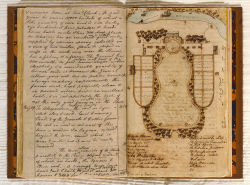
- Brissot de Warville, J. P., 1788, describing Mount Vernon, plantation of George Washington, Fairfax County, VA (1792: 428–29)[18]
- “The General came home in the evening, fatigued with having been to lay out a new road in some part of his plantations. You have often heard him compared to Cincinnatus: the comparison is doubtless just. This celebrated General is nothing more at present than a good farmer, considerably occupied in the care of his farm and the improvement of cultivation. He has lately built a barn. . . It is built on a plan sent him by that famous English farmer Arthur Young. But the General has much improved the plan. . . His three hundred negroes are distributed in different log houses, in different parts of his plantation, which in this neighborhood consists of ten thousand acres.” [Fig. 10]
- Anonymous, January 21, 1790, describing in the Virginia Herald and Fredericksburg Advertiser a property for sale in Orange County, VA (Colonial Williamsburg Foundation)
- “To be sold, The place where I reside in Orange County, lying on the great mountain road, 30 miles from Fredericksburg, consisting of 850 acres of well timbered land, adapted to the growth of small grain. There is upon this plantation, 50 acres laid down in a variety of the best English grasses. . . also, a very flourishing young orchard containing 7 acres of the choicest apple and peach trees, part of which bore last summer; a good garden, planted round with a thorn hedge, and a lawn of 10 acres surrounding the dwelling houses.”
- Bartram, William, 1791, describing an Indian town in Georgia (1928: 169–70)[19]
- “They plant but little here about the town; only a small garden plot at each habitation. . . Their plantation, which supplies them with the chief of their vegetable provisions. . . lies on the rich prolific lands bordering on the great Alachua savanna, about two miles distance. This plantation is one common enclosure, and is worked and tended by the whole community.”
- Dwight, Timothy, 1796, describing New England (1821: 1:335–38)[20]
- “It is remarkable fact, that New-England was colonized in a manner, widely different from that, which prevailed in the other British Colonies. All the ancient, and a great part of the modern, townships were settled in what may be called the village manner: the inhabitants having originally planted themselves in small towns. In many other parts of this country the planters have almost universally fixed themselves on their several farms: each placing his house where his own convenience dictated. In this manner, it is evident, the farmer can more advantageously manage his property; can oversee it more readily; and labour on it with fewer interruptions; than when it is dispersed in fields at some distance from each other.
- “But scattered plantations are subject to many serious disadvantages. Neither schools, nor churches, can without difficulty be either built by the planters, or supported. . .
- “At the same time, persons, who live on scattered plantations, are in a great measure cut off from that daily intercourse, which softens and polishes man. . .
- “New-England presents a direct contrast to this picture. Almost the whole country is covered with villages: and every village has its church, and its suit of schools. . . Even the scattered plantations in New-England have retained in great measure the national characteristics of their country. Those, by whom these plantations were formed, had their education in the villages; and, when they emigrated, were too far advanced in life to relinquish their character and habits. Accordingly they built churches, and schools; and in the midst of various difficulties maintained the same social intercourse.”
- Dwight, Timothy, 1796, describing Pleasant Hill (also known as Cobble Hill), seat of Joseph Barrell, Charlestown, MA (1821: 1:489)[20]
- “MONDAY, October, 14th, we visited Cobble Hill; the handsome seat of Joseph Barrell Esq. This ground, while the British continued in Boston, was a place of much notoriety as a scene of military transactions. It is now a beautiful plantation; and, considering the short period since it was begun, highly improved.”
- Anonymous, September 21, 1796, advertisement in the Pennsylvania Gazette of sale property in Bucks County, PA (Dillon 1987: 143)[21]
- “FOR SALE, A PLANTATION. . . in the county of Bucks. . . a well of good water near the kitchen door, and neat garden pailed in.”
- Davis, John, 1798–1802, describing Ocean Plantation, property of Thomas Drayton, Jasper County, SC (quoted Jones 1957: 79–81)[22]
- “To form an idea of Ocean Plantation, let the reader picture to his imagination an avenue of several miles, leading from the Savannah road, through a continued forest, to a wooden-house, encompassed by rice-grounds, corn and cotton fields. . .
- “In my walk to Coosawhatchie [a nearby town] I passed here and there a plantation, but to have called on its owner without a previous introduction, would have been a breach of that etiquette which has its source from the depravity of great cities, but has not failed to find its way into the woods of America.
- “Though the plantation of Mr. Drayton was immense, his dwelling was only a log-house.”
- La Rochefoucauld Liancourt, François Alexandre-Frédéric, duc de, 1799, describing the plantations of Charleston, SC (1800: 2:435–38)[23]
- “This small plantation, named Fitterasso, consists of four hundred acres, and cost him [Dr. Baron] four thousand two hundred and eighty dollars; it is situated on a small eminence near the river. . . :
- “Hence we crossed the river, and stopped at a plantation, lately purchased by Mr. Pringle. . . This plantation is likewise without a house, that of the former occupier having been consumed by fire. . . The plantation, which consists of four hundred acres, has cost him one thousand two hundred and eighty-five dollars. The situation is much the same as that of Fitterasso. . .
- “We made another halt at a house, formerly the property of Commodore GILLON. . . The house is tolerably handsome, and the garden is laid out with a more refined taste, and cultivated with more care than gardens generally are in this country. But the soil is sterile to such a degree, that the Commodore was obliged to supply his table with culinary plants, and his stable with fodder, from another plantation, which he possessed three or four miles farther distant.
- “Half a mile from Batavia, the name of the Commodore’s plantation, stands Middleton-house, the property of Mrs. MIDDLETON, mother-in-law to young Mr. Isard, which is esteemed the most beautiful house in this part of the country. The out-buildings, such as kitchen, wash-house, and offices, are very capacious. The ensemble of these buildings calls to recollection the ancient English Country-seats. The rooms in the house are small, and the outside, as well as the inside, is badly kept. A peculiar feature of the situation is this, that the river, which flows in a circuitous course, until it reaches this point, forms here a wide, beautiful canal, pointing straight to the house. The garden is beautiful, but kept in the same manner as the house; the soil is very bad, and, in my opinion, the whole plantation is altogether undeserving the celebrity it enjoys.”
- Anonymous, c. 1800, describing the land around the Elias Hasket Derby House, Salem, MA (Peabody Essex Institute, Phillips Library, Derby Papers)
- Michaux, François André, 1802, describing East Florida (1805: 349)[24]
- “It is fifty years since the seeds of this species [sweet orange] were brought from India, and given to an inhabitant of this island [Sant Anastasia], who has increased them so much as to have made an orchard of them of forty acres. I had an opportunity of seeing this fine plantation when I was in Florida, in 1788.”
- Anonymous, February 18, 1803, describing a property for sale in Orange County, VA (Virginia Herald)
- “FOR SALE, the Tract of Land, which was formerly the Glebe, in the county of Orange, lying within two miles of the court house, and contains 361 acres, which are well adapted to the growth of corn, wheat and tobacco.—68 bushels of wheat is sown on the plantation, which looks promissing, and is under good fencing.”
- Lambert, John, 1816, describing Vauxhall Garden, New York, NY (1816: 2:61)[25]
- “New York has its Vauxhall and Ranelah; but they are poor imitations of those near London. They are, however, pleasant places of recreation for the inhabitants. The Vauxhall garden is situated in the Bowery Road about two miles from the City Hall. It is a neat plantation, with gravel walks adorned with shrubs, trees, busts, and statues.”
- Lambert, John, 1816, describing a plantation near Charleston, SC (1816: 2:243)[26]
- “After walking two or three miles I came to a large plantation. Here the negroes were employed in hoeing the earth, clearing the neighbouring forests, and carrying the wood upon their heads to different parts for the purpose of fencing in the grounds; men, women, and children were all busily engaged under the superintendance of an overseer. The house, which was but indifferent, stood a considerable distance from the road. I saw no cattle or poultry of any description; indeed, a plantation has very rarely the comfortable appearance of a farm.”
- Ticknor, George, December 16, 1824, in a letter to William H. Prescott, describing Montpelier, plantation of James Madison, Montpelier Station, VA (quoted in Jones 1957: 8)[22]
- “On Sunday afternoon we took a ride of a dozen miles across different plantations, to see the country and the people. Mr. Madison’s farm—as he calls it—consists of about three thousand acres, with an hundred and eighty slaves, and is among the best managed in Virginia. We saw also one or two others that looked very well, but in general things had a very squalid appearance.”
- Douglass, Frederick, 1825, describing Wye House, estate of Col. Edward Lloyd, Talbot County, MD (1855; repr., 1987: 46–48)[27]
- “Then here were a great many houses; human habitations, full of the mysteries of life at every stage of it. . . Old master’s house, a long, brick building, plain, but substantial, stood in the center of the plantation life, and constituted one independent establishment on the premises of Col. Lloyd.
- “Besides these dwellings, there were barns, stables, store-houses, and tobacco-houses; blacksmiths’ shops, wheelwrights’ shops, coopers’ shops—all objects of interest; but, above all, there stood the grandest building my eyes had then ever beheld, called, by every one on the plantation, the ‘Great House.’ This was occupied by Col. Lloyd and his family. They occupied it; I enjoyed it. . .
- “The business of twenty or thirty farms was transacted at this, called, by way of eminence, ‘great house farm.’ These farms all belonged to Col. Lloyd, as did, also, the slaves upon them. Each farm was under the management of an overseer. As I have said of the overseer of the home plantation, so I may say of the overseers on the smaller ones; they stand between the slave and all civil constitutions—their word is law, and is implicitly obeyed.”
- Anonymous, April 28, 1826, describing landscapes and picturesque gardens (New England Farmer 4: 316)[28]
- “The country seats which surround the city of New-York are most beautifully situated, but we cannot avoid a feeling of regret at not seeing them accompanied with some plantations and groups of trees happily disposed, which would not only add to their beauty and afford cool and shaded walks, so agreeable during the heats of summer, but would have the advantage of increasing the real value of the property, in proportion to the number and value of the plantations made.”
- Commissioner of Public Buildings, June 9, 1827, describing the Columbian Institute, Washington, DC (quoted in O’Malley 1989: 133)[29]
- “The new section of the Washington Canal was laid out along a line drawn through the middle of the Capitol and of the Mall. The pathway, canal and plantation in the garden do not coincide with this line, but diverge from it at an acute angle.”
- Teschemacher, James E., November 1, 1835, describing the vicinity of Boston, MA (Horticultural Register 1: 411–12)[30]
- “The vicinity of Boston abounds so much in every variety of beautiful landscape, that there is scarcely any place where art is less required in laying out pleasure grounds . . . after leaving this paradise of sweets, passing some distance through a thick plantation of the most ornamental forest trees of America, including the varieties of pine and fir, then suddenly emerging on the beautiful expanse of grass lawn in front; all this, owing to the natural advantages of the country surrounding Boston, may be accomplished at a comparatively trifling expense and loss of time.”
- Anonymous, April 1, 1837, describing Landscape Gardening (Horticultural Register and Gardener's Magazine 3: 130)[31]
- "Few are able to devote much ground or much expense in extensive ornamental plantation; but all may decorate the immediate vicinity of their residencies. The house should be situated at some distance from the road, which distance should be greater or less according as the house is large or small, and it should be on a moderate rise of ground. There should be a spacious open lawn or grass ground in front, which should be unoccupied by any objects except an occasional small groups of trees. . . If it is situated on an eminence, the back as well as front view may be exhibited to great advantage. . ."
- Lyell, Charles, 1846, describing banks of the Mississippi River (1849: 2:115)[32]
- “The growth of willows on that side of the stream where the land is gaining on the water, is often so formal and regular, that they look like an artificial plantation.”
Citations
- Smith, Capt. John, 1612, Map of Virginia (Oxford English Dictionary 1989: 976)
- “In Aprill they begin to plant, but their chiefe plantation is in May.”
- Milton, John, 1667, Paradise Lost (Oxford English Dictionary 1989: 976)
- “In Bowre and Field he sought, where any tuft Of Grove or Garden Plot more pleasant lay, Thir tendance or Plantation for delight.”
- La Quintinie, Jean de, 1693, “Dictionary,” The Compleat Gard’ner (1693; repr., 1982: n.p.)[33]
- “Plantation is a piece of Ground stocked with plants of any sort, or of many kinds.”
- Phillips, Edward, 1706, New World of Words (1720: n.p.)[34]
- “Plantation, a planting, or setting; a Company = of People sent from one Country to settle in another: Also a Spot of Ground in America for the planting of Tobacco, Sugar-Canes, &c.”
- Chambers, Ephraim, 1743, Cyclopaedia (1743: 2:n.p.)[35]
- “PLANTATION, in the islands and continent of America, a spot of ground which some planter, or person arrived in a new colony, pitches on to cultivate and till for his own use. See COLONY.”
- Johnson, Samuel, 1755, A Dictionary of the English Language (1755: 2:n.p.)[36]
- “PLANTA’TION. n.s. [plantatio, from planto, Latin.]
- “1. The act or practice of planting.
- “2. The place planted. . .
- “3. A colony.”
- Marshall, William, 1803, On Planting and Rural Ornament (1803: 1:23, 145, 255)[37]
- “TREES and SHRUBS may be trained up from the seed bed, &c. until they be fit to be planted out to stand, either in NURSERIES set apart for the purpose, or in YOUNG PLANTATIONS; which last are frequently the most eligible nurseries. . .
- “THE TIMBER GROVE is the prevailing plantation of modern time. . .
- “In forming ORNAMENTAL PLANTATIONS, two things are to be considered, the species of plantation, and the species of tree.
- “THE different species of plantation are the Wood, the Grove, the Coppice or Thicket, the Border or Skreen, the Mass, Clump, or Turf, the Group, and the Single Tree.”
- M’Mahon, Bernard, 1806, American Gardener’s Calendar (1806: 55, 57)[38]
- “THE district commonly called the Pleasure, or Flower-Garden, or Pleasure-ground, may be said to comprehend all ornamental compartments, or divisions of ground, surrounding the mansion; consisting of lawns, plantations of trees and shrubs, flower compartments, walks, pieces of water, &c. whether situated wholly within the space generally considered as the Pleasure-Garden, or extended to the adjacent fields, parks, or other out-grounds. . .
- “For instance, a grand and spacious open lawn, of grass-ground, is generally first presented immediately to the front of the mansion, or main habitation; sometimes widely extended on both sides, to admit of a greater prospect, &c. and sometimes more contracted towards the habitation; widening gradually outwards, and having each side embellished with plantations of shrubbery, clumps, thickets, &c. in sweeps, curves, and projections, towards the lawn; with breaks or opens of grass-spaces at intervals, between the different plantations; together with serpentine gravel walks, winding under the shade of the trees: extended plantations ought also to be carried round next the outer boundary of the pleasure-ground, when extensive; in various openings and closings, having gravel walks winding through them, for shady and private walking. . .
- “First an open lawn of grass-ground is extended on one of the principle fronts of the mansion or main house, widening gradually from the house outward, having each side bounded by various plantations of trees, shrubs, and flowers, in clumps, thickets, &c. exhibited in a variety of rural forms, in moderate concave and convex curves, and projections, to prevent all appearance of a stiff uniformity; introducing between the plantations at intervals, breaks or opens of grass-ground, communicating with the lawn and internal divisions, in some places widely spread, in others more contracted; leaving also tracts for serpentine gravel-walks, some winding under the shade of the plantations, so conducted as to command views of the lawn and interior divisions occasionally, and at intervals, of the most beautiful parts of the surrounding country.”
- Nicol, Walter, 1812, Planter’s Kalendar (1812: 43–44, 151)[39]
- “It may be proper here to remind the reader of the difference between a wood and a plantation. A wood, then, is always understood to be either entirely a natural production; or to be sown, not planted, by man; and to consist of a mixture of timber trees, chiefly of oak and ash, with underwood or shrubs, as willow, hazel, holly, birch, or thorn. Some natural woods, however, particularly in Scotland, consist almost entirely of fir-trees, with, sometimes, a mixture of birch, mountain-ash, and several kinds of shrubs. The extent of a wood may be any thing, from an acre, or half an acre, to many square miles: when of this last size, it assumes the appearance of a forest, and generally receives that denomination. . .
- “Hence in rearing of a wood we have a variety of examples, and a choice of situation, set before us. One rule we must invariably adhere to; namely, to sow, and not to plant. All the woods of nature are raised from the seeds, sown on the spot where the trees grow; and we are certain that her timber trees are never inferior, but often superior to such as have been planted by the hand of man. . .
- “Screen plantations are, as implied in their name, intended either to shelter from the wind, or to cover some disagreeable object from the view. Screen plantations, therefore, are generally furnished with a stock of underwood, such as Holly, Yew, Laurel, Spruce, Hazel and the like.”
- Gregory, G. (George), 1816, A New and Complete Dictionary of Arts and Sciences (1816: 2:n.p.)[40]
- “GARDENING. . . .
- “As to trees planted without the wall, to break the wind, we cannot expect to reap much good this way, except from something more than a single row, i.e. a plantation.”
- Loudon, J. C. (John Claudius), 1826, An Encyclopaedia of Gardening (1826: 950, 952)[41]
- “6853. The situations [of plantations] to be planted, with a view to effect, necessarily depends on the kind of effect intended; these may reduced to three—to give beauty and variety to general scenery, as in forming plantations here and there throughout a demesne; to give form and character to a country-residence, as in planting a park and pleasure-grounds; and to create a particular and independent beauty or effect, as in planting an extensive area or wood, unconnected with any other object, and disposing of the interior in avenues, glades, and other forms. . .
- “6855. The outline of plantations, made with a view to the composition of a country-residence, is guided by the same general principles; whether the trees are to be disposed in regular forms, avowedly artificial; or in irregular forms, in imitation of nature. . . The first thing is, in both modes, to compose a principal mass, from which the rest may appear to proceed; or be, or seem to be, connected.”
- Parmentier, André, 1828, New American Gardener (quoted in Fessenden 1828: 186)[42]
- “The plantations and groups of trees near the house should be, if possible, of a deeper green;— they would extend the view and the perspective, and produce the effect of shades in a landscape-picture, where the groups of trees in front are of a darker shade, and seem to remove the perspective from the extremity of the landscape. . .
- “Plantations should consist of, besides merely ornamental trees, those fruit-trees which are high and of bright foliage. Their flowers in spring, and branches loaded with fruit in autumn, make them objects of great beauty and interest.”
- Webster, Noah, 1828, An American Dictionary of the English Language (1828: 2:n.p.)[43]
- “PLANTA’TION, n. [L. plantatio, from planto, to plant.]
- “1. The act of planting or setting in the earth for growth.
- “2. The place planted; applied to ground planted with trees, as an orchard or the like. Addison.
- “3. In the United States and the West Indies, a cultivated estate; a farm. In the United States, this word is applied to an estate, a tract of land occupied and cultivated, in those states only where the labor is performed by slaves, and where the land is more or less appropriated to the culture of tobacco, rice, indigo and cotton, that is, from Maryland to Georgia inclusive, on the Atlantic, and in the western states where the land is appropriated to the same articles or to the culture of the sugar cane. From Maryland, northward and eastward, estates in land are called farms.
- “4. An original settlement in a new country; a town or village planted. . .
- “5. A colony.
- “6. A first planting; introduction; establishment; as the plantation of Christianity in England. K. Charles.”
- Bridgeman, Thomas, 1832, The Young Gardener’s Assistant (1832: 110)[44]
- “A Flower Garden should be protected from cold cutting winds by close fences, or plantations of shrubs, forming a close and compact hedge.”
- Teschemacher, James E., November 1, 1835, “On Horticultural Architecture” (Horticultural Register 1: 412)[30]
- “There is also some management necessary in working up such landscapes with an artist’s eye, by opening vistas through plantations, concealing barns and out buildings or kitchen gardens by judicious management of clumps of trees, or permitting small glimpses of the flower garden by gaps in the shrubberies—an ornamental roof of a greenhouse partly concealed by foliage is an elegant object.”
- Sayers, Edward, November 1, 1837, “On Laying out Gardens and Ornamental Plantations” (Horticultural Register 3: 410)[45]
- “. . . the planting of ornamental forest trees is really useful as relates to the domestic comforts of the inmates of dwellings, that are protected and ornamented by them; by affording shade in the summer and protecting the building from the cold blast of winter. Ornamental plantations of this kind also give a mellow and finished cast to the surrounding scenery, and impress the traveller with an idea of the additional value of property, arising from an enterprising and intelligent community.”
- Sayers, Edward, January 1, 1838, “On Laying out Gardens and Ornamental Plantations: Choice of Trees for Ornamental and Landscape Plantations” (Horticultural Register 4: 5–6)[46]
- “Native forest trees will be found, in most cases, to answer the best purpose for the park and exposed plantations (with the exception of some few varieties of foreign trees) their natural properties being particularly adapted to this climate; consequently, they always assume a healthy appearance, which is the greatest consideration in landscape scenery; as ornamental trees when in a sickly state, destroy that pleasing effect they are intended to produce.”
- Johnson, George William, 1847, A Dictionary of Modern Gardening (1847: 462)[47]
- “PLANTATION. The ornamental distribution of trees is considered under the titles Clump, Wood, &c.; and here will be considered only a few practical details relative to the planting and management of trees.”
- Downing, Andrew Jackson, 1841, describing the residence of David Hosack (1841: 22, 372–73, 385)[48]
- “Hyde Park, on the Hudson, the seat of the late Dr. Hosack, has been justly celebrated as one of the finest specimens of the modern style of Landscape Gardening in America. [. . .] But the efforts of art are not unworthy so rare a locality; and while the native woods, and beautifully undulating grounds are preserved in their original state, the pleasure-grounds, roads, walks, drives, and new plantations, have been laid out in so tasteful a manner as to heighten the charms of nature."
- Downing, Andrew Jackson, 1849, A Treatise on the Theory and Practice of Landscape Gardening (1849; repr., 1991: 88, 93, 94–95, 104–8, 182, 219)[49]
- “If it were necessary to present any other inducement to the country gentleman to form plantations of trees, than the great beauty and value which they add to his estate, we might find it in the pleasure which all derive from their cultivation. . .
- “His [the homeowner’s] plantations are made in irregular groups, composed chiefly of picturesque trees, as the larch, &c.—his walks would lead through varied scenes, sometimes bordered with groups of rocks overrun with flowering creepers and vines; sometimes with thickets or little copses of shrubs and flowering plants; sometimes through wild and comparatively neglected portions; the whole interspersed with open glades of turf. . .
- “PLANTATIONS IN THE MODERN STYLE. In the Modern Style of Landscape Gardening, it is our aim, in plantations, to produce not only what is called natural beauty, but even higher and more striking beauty of expression, and of individual forms, than we see in nature; to create variety and intricacy in the grounds of a residence by various modes of arrangement; to give a highly elegant or polished air to places by introducing rare and foreign species; and to conceal all defects of surface, disagreeable views, unsightly buildings, or other offensive objects. . .
- “There will be the same open glades in picturesque as in beautiful plantations; but these openings, in the former, will be bounded by groups and thickets of every form, and of different degrees of intricacy, while in the latter the eye will repose on softly rounded masses of foliage, or single open groups of trees, with finely balanced and graceful heads and branches.
- “In order to know how a plantation in the Picturesque mode should be treated, after it is established, we should reflect a moment on what constitutes picturesqueness in any tree. This will be found to consist either in a certain natural roughness of bark, or wildness of form and outline, or in some accidental curve of a branch of striking manner of growth, or perhaps of both these conjoined. A broken or crooked limb, a leaning trunk, or several stems springing from the same base, are frequently peculiarities that at once stamp a tree as picturesque. . .
- “In all grounds to be laid out, however, which are of a lawn or park-like extent, and call for the exercise of judgment and taste, the mansion or dwelling-house, being itself the chief or leading object in the scene, should form, as it were, the central point, to which it should be the object of the planter to give importance. In order to do this effectually, the large masses or groups of wood should cluster round, or form the back-ground to the main edifice; and where the offices or outbuildings approach the same neighborhood, they should also be embraced. . .
- “From this principal mass, the plantations must break off in groups of greater or less size, corresponding to the extent covered by it; if large, they will diverge into masses of considerable magnitude, if of moderate size, in groups made up of a number of trees. In the lawn front of the house, appropriate places will be found for a number of the most elegant single trees, or small groups of trees, remarkable for the beauty of their forms, foliage, or blossoms. Care must be taken, however, in disposing these, as well as many of the groups, that they are not placed so as, at some future time, to interrupt or disturb the finest points of prospect.
- “In more distant parts of the plantations will also appear masses of considerable extent, perhaps upon the boundary line, perhaps in particular situations on the sides, or in the interior of the whole; and the various groups which are distributed between should be so managed as, though in most cases distinct, yet to appear to be the connecting links which unite these distant shadows in the composition, with the larger masses near the house. Sometimes several small groups will be almost joined together; at others the effect may be kept up by a small group, aided by a few neighboring single trees. This, for a park-like place. Where the place is small, a pleasure-ground character is all that can be obtained. But by employing chiefly shrubs, and only a few trees, very similar and highly beautiful effects may be attained.

- “The grand object in all this should be to open to the eye, from the windows or front of the house, a wide surface, partially broken up and divided by groups and masses of trees into a number of pleasing lawns or openings, differing in size and appearance, and producing a charming variety in the scene, either when seen from a given point or when examined in detail. It must not be forgotten that, as a general rule, the grass or surface of the lawn answers as the principal light, and the woods or plantations as the shadows, in the same manner in nature as in painting; and that these should be so managed as to lead the eye to the mansion as the most important object when seen from without, or correspond to it in grandeur and magnitude, when looked upon from within the house. If the surface is too much crowded with groups of foliage, breadth of light will be found wanting; if left too bare, there will be felt, on the other hand, an absence of the noble effect of deep and broad shadows. . . [Fig. 11]
- “Like the lime tree, however, care must be taken, in the modern style, to introduce it [the Horsechestnut] rather sparingly in picturesque plantations, and then only as a single tree, or upon the margin of large groups, masses, or plantations; but it may be more freely used in grounds in the graceful style, for which it is highly suitable. . .
- “When the Black walnut stands alone on a deep fertile soil it becomes a truly majestic tree; and its lower branches often sweep the ground in a graceful curve, which gives additional beauty to its whole expression. It is admirably adapted to extensive lawns, parks, or plantations, where there is no want of room for the attainment of its full size and fair proportions.”
Images
Inscribed
John L. Boqueta de Woiseri, A View of New Orleans taken from the plantation of Marigny, November 1803.
J. C. Loudon, The placement of groups and thickets in plantations, in An Encyclopaedia of Gardening, 4th ed. (1826), 954, fig. 649.
J. C. Loudon, Clump of Scotch pines, in An Encyclopaedia of Gardening, 4th ed. (1826), 965, fig. 663. "Ornamental plantations are no less frequently neglected than such as are considered chiefly useful."
J. C. Loudon, Kitchen garden, in An Encyclopaedia of Gardening, new ed. (1834), 721, fig. 696.
Anonymous, “Grouping to produce the Picturesque,” in A. J. Downing, A Treatise on the Theory and Practice of Landscape Gardening, 4th ed. (1849), 103, fig. 22. “Picturesque plantations.”
Associated
Sketch plan of Mount Vernon, June–September 1787.
William Bartram, Plan of a “plantation” (or “villa”) of a Creek Indian chief, in “Observations on the Creek and Cherokee Indians” (1789), from Transactions of the American Ethnological Society 3, part 1 (1853): 38, fig. 1.
George Washington, “Survey and plot of Mount Vernon and neighboring farms,” 1793.
Thomas Coram, View of Mulberry, House and Street, c. 1800.
Anonymous, “Montpelier, Va., the Seat of the late James Madison,” 1835.
Anonymous, “View in the Grounds at Hyde Park,” in A. J. Downing, A Treatise on the Theory and Practice of Landscape Gardening, 4th ed. (1849), pl. opp. 45, fig. 1.
Anonymous, “The Seat of George Sheaff, Esq.” in A. J. Downing, A Treatise on the Theory and Practice of Landscape Gardening, 4th ed. (1849), pl. between 58 and 59, fig. 12.
Attributed
Andreas Anton Lawatsch, “Prospect of Bethabara,” Salem, NC, c. 1759.
Thomas Coram, “View at St. James’s Goose Creek,” 1792.
Charles Fraser, Mrs. Robert Gibbes’ Place, John’s Island, May 1797.
Charles Fraser, The Seat of Jos. Winthrop, Esq., Goose Creek, c. 1800.
Francis Guy, Perry Hall, Slave Quarters with Field Hands at Work, c. 1805.
Notes
- ↑ For general histories about plantation life, see Eugene D. Genovese, Roll, Jordan, Roll: The World the Slaves Made (New York: Pantheon, 1974), view on Zotero; Mechal Sobel, The World They Made Together: Black and White Values in Eighteenth-Century Virginia (Princeton, NJ: Princeton University Press, 1987), view on Zotero; and Sam B. Hillard, “Plantations and the Molding of the Southern Landscape,” in The Making of the American Landscape, ed. Michael P. Conzen (New York: Routledge, 1990), 104–26, view on Zotero.
- ↑ John Vlach credits John Pendleton Kennedy’s Swallow Barn, or A Sojourn in the Old Dominion (1832) as the first portrayal of the romantic idealization of southern plantation life, a myth carried on by 150 years of fiction and film. See John Michael Vlach, Back of the Big House: The Architecture of Plantation Slavery (Chapel Hill: University of North Carolina Press, 1993), 21, view on Zotero. This idea is also explored at length in Edward D. C. Campbell, The Celluloid South: Hollywood and the Southern Myth (Knoxville: University of Tennessee Press, 1981), view on Zotero.
- ↑ Vlach 1993, 21, view on Zotero.
- ↑ Both Hilliard 1990, view on Zotero, and Vlach 1993, view on Zotero, provide excellent discussions of the varying patterns of plantation landscapes of the antebellum South, drawing comparisons among Tidewater and Piedmont tobacco and grain plantations, coastal rice plantations, Deep South’s cotton plantations, and the lower Mississippi’s sugar plantations.
- ↑ Theresa Singleton provides an overview of the archaeology of plantations, including a discussion of the variety of dwellings for the enslaved. “The Archaeology of Slave Life,” in Before Freedom Came: African-American Life in the Antebellum South, ed. Edward D. C. Campbell Jr. and Kym S. Rice (Charlottesville: Museum of the Confederacy and the University Press of Virginia, 1991), 155–91, view on Zotero.
- ↑ Vlach 1993, 142–52, view on Zotero.
- ↑ Terrence W. Epperson “Race and Disciplines of the Plantation,” Historical Archaeology 24, no. 4 (1990): 29–36, view on Zotero; Dell Upton, “White and Black Landscapes in Eighteenth-Century Virginia,” in Material Life in America, 1600–1860, ed. Robert Blair St. George (Boston: Northeastern University Press, 1988), 357–69, view on Zotero; and Dell Upton, Holy Things and Profane: Anglican Parish Churches in Colonial Virginia (New York: Architectural History Foundation; Cambridge, MA: MIT Press, 1986), 214–18, view on Zotero.
- ↑ Philip Miller, The Gardeners Dictionary (London: Philip Miller, 1759), n.p., view on Zotero.
- ↑ 9.0 9.1 Perry Miller and Thomas H. Johnson, eds., The Puritans, 2 vols., (New York: Harper and Row, 1963), view on Zotero.
- ↑ Carl R. Lounsbury, ed., An Illustrated Glossary of Early Southern Architecture and Landscape (New York: Oxford University Press, 1994), view on Zotero.
- ↑ Richard Blome, The Present State of His Majesties Isles and Territories in America (London: H. Clark, 1687), view on Zotero.
- ↑ Alice B. Lockwood, ed., Gardens of Colony and State: Gardens and Gardeners of the American Colonies and of the Republic before 1840, 2 vols. (New York: Charles Scribner’s for the Garden Club of America, 1931), view on Zotero.
- ↑ Alexander Spotswood and John Spotswood, “Correspondence with John Spotswood of Edinburgh,” Virginia Magazine of History and Biography 60 (1952): 211–40, view on Zotero.
- ↑ Louis B. Wright and Marion Tinling, eds., The Secret Diary of William Byrd of Westover, 1709–1712 (New York: Arno Press, 1972), view on Zotero.
- ↑ Marion Tinling, ed., The Correspondence of the Three William Byrds of Westover, Virginia, 1684–1776, 2 vols. (Charlottesville: University Press of Virginia, 1977), view on Zotero.
- ↑ 16.0 16.1 Thomas Anburey, Travels through the Interior Parts of America, 2 vols. (1789; repr., New York: New York Times and Arno Press, 1969), view on Zotero.
- ↑ George Washington, The Diaries of George Washington, ed. Donald Jackson and Dorothy Twohig, 6 vols. (Charlottesville: University Press of Virginia, 1978), view on Zotero.
- ↑ J.-P. (Jacques-Pierre) Brissot de Warville, New Travels in the United States of America, Performed in 1788, ed. Durand Echeverria, trans. Maro S. Vamos and Durand Echeverria (Cambridge, MA: Belknap, 1964), view on Zotero.
- ↑ William Bartram, Travels through North and South Carolina, Georgia, East and West Florida, ed. Mark Van Doren (New York: Dover, 1928), view on Zotero.
- ↑ 20.0 20.1 Timothy Dwight, Travels in New England and New York, 4 vols. (New Haven, CT: Timothy Dwight, 1821), view on Zotero.
- ↑ Clarissa F. Dillon, “‘A Large, an Useful, and a Grateful Field’: Eighteenth-Century Kitchen Gardens in Southeastern Pennsylvania, the Uses of the Plants, and Their Place in Women’s Work” (PhD diss., Bryn Mawr College, 1987), view on Zotero.
- ↑ 22.0 22.1 Katharine M. Jones, The Plantation South (New York: Bobbs-Merrill, 1957), view on Zotero.
- ↑ François-Alexandre-Frédéric, duc de La Rochefoucauld Liancourt, Travels through the United States of North America, the Country of the Iroquois, and Upper Canada, in the Years 1795, 1796, and 1797, eds. Brisson Dupont and Charles Ponges, trans. H. Newman, 2nd ed., 4 vols. (London: R. Philips, 1800), view on Zotero.
- ↑ François André Michaux, Travels to the West of the Alleghany Mountains, in the States of Ohio, Kentucky, and Tennessea, and back to Charleston, by the Upper Carolines. . . Undertaken, in the Year 1802, 2nd ed. (London: B. Crosby & Co. and J. F. Hughes, 1805), view on Zotero.
- ↑ John Lambert, Travels through Canada, and the United States of North America in the Years 1806, 1807, and 1808, 2 vols. (London: Baldwin, Cradock, and Joy, 1816), 61 view on Zotero.
- ↑ Lambert 1816, vol. 2, 243, view on Zotero.
- ↑ Frederick Douglass, My Bondage and My Freedom, ed. William L. Andrews (1855; Urbana, IL: University of Illinois Press, 1987), view on Zotero.
- ↑ Anonymous, “On Landscape and Picturesque Gardens,” New England Farmer 4, no. 40 (April 28, 1826): 316, view on Zotero.
- ↑ Therese O’Malley, “Art and Science in American Landscape Architecture: The National Mall, Washington, D.C. 1791–1852” (PhD diss., University of Pennsylvania, 1989), view on Zotero.
- ↑ 30.0 30.1 James E. Teschemacher, “On Horticultural Architecture,” Horticultural Register, and Gardener’s Magazine 1 (November 1, 1835): 409–12, view on Zotero.
- ↑ Horticultural Register and Gardener's Magazine, edited by Joseph Breck, (April 1, 1837), 130, view on Zotero.
- ↑ Sir Charles Lyell, A Second Visit to the United States of North America, 2 vols. (New York: Harper, 1849), view on Zotero.
- ↑ Jean de La Quintinie, The Compleat Gard’ner, or Directions for Cultivating and Right Ordering of Fruit-Gardens and Kitchen Gardens, trans. John Evelyn (1693; repr., New York: Garland, 1982), view on Zotero.
- ↑ Edward Phillips, New World of Words, or Universal English Dictionary, 7th ed. (London: J. Phillips, 1720), view on Zotero.
- ↑ Ephraim Chambers, Cyclopaedia, or An Universal Dictionary of Arts and Sciences . . . , 5th ed., 2 vols. (London: D. Midwinter et al., 174143), view on Zotero.
- ↑ Samuel Johnson, A Dictionary of the English Language: In Which the Words Are Deduced from the Originals and Illustrated in the Different Significations by Examples from the Best Writers, 2 vols. (London: W. Strahan for J. and P. Knapton, 1755), view on Zotero.
- ↑ William Marshall, On Planting and Rural Ornament: A Practical Treatise . . . , 2 vols. (London: G. and W. Nicol, G. and J. Robinson, T. Cadell, and W. Davies, 1803), view on Zotero.
- ↑ Bernard M’Mahon, American Gardener’s Calendar: Adapted to the Climates and Seasons of the United States. Containing a Complete Account of All the Work Necessary to Be Done. . . for Every Month of the Year . . . , view on Zotero.(Philadelphia: Printed by B. Graves for the author, 1806)
- ↑ Walter Nicol, Planter’s Kalendar (Edinburgh: D. Willison for A. Constable, 1812), view on Zotero.
- ↑ George Gregory, A New and Complete Dictionary of Arts and Sciences, 1st American ed., 3 vols. (Philadelphia: Isaac Peirce, 1816), view on Zotero.
- ↑ J. C. (John Claudius) Loudon, An Encyclopaedia of Gardening; Comprising the Theory and Practice of Horticulture, Floriculture, Arboriculture, and Landscape-Gardening, 4th ed. (London: Longman et al., 1826), view on Zotero.
- ↑ Thomas Fessenden, New American Gardener (Boston: J. B. Russell, 1828), view on Zotero.
- ↑ Noah Webster, An American Dictionary of the English Language, 2 vols. (New York: S. Converse, 1828), view on Zotero.
- ↑ Thomas Bridgeman, The Young Gardener’s Assistant, 3rd ed. (New York: Geo. Robertson, 1832), view on Zotero.
- ↑ Edward Sayers, “On Laying out Gardens and Ornamental Plantations,” Horticultural Register, and Gardener’s Magazine 3 (November 1, 1837): 409–11, view on Zotero.
- ↑ Edward Sayers, “On Laying Out Gardens and Ornamental Plantations,” Horticultural Register, and Gardener’s Magazine 4 (January 1, 1838): 62, view on Zotero.
- ↑ George William Johnson, A Dictionary of Modern Gardening, ed. David Landreth (Philadelphia: Lea and Blanchard, 1847), view on Zotero.
- ↑ Andrew Jackson Downing, A Treatise on the Theory and Practice of Landscape Gardening, Adapted to North America. . . (New York and London: Wiley & Putnam, 1841), view on Zotero.
- ↑ A. J. [Andrew Jackson] Downing, A Treatise on the Theory and Practice of Landscape Gardening, Adapted to North America, 4th ed. (Washington, DC: Dumbarton Oaks Research Library and Collection, 1991), view on Zotero.
